Toyota Avalon (XX50): Pressure Control Solenoid "H" Circuit Short to Ground or Open (P281614). Parts Location. Precaution
Pressure Control Solenoid "H" Circuit Short to Ground or Open (P281614)
DESCRIPTION
Refer to DTC P281612.
Click here

|
DTC No. | Detection Item |
DTC Detection Condition | Trouble Area |
MIL | Memory |
Note |
| P281614 |
Pressure Control Solenoid "H" Circuit Short to Ground or Open |
While
the vehicle is being driven so that gear changes occur, a short to
ground or open is detected in the solenoid (SL5) valve circuit for 1
second (1-trip detection logic). |
- Solenoid (SL5) valve
- Transmission wire
- Harness and connector
- ECM
| Comes on |
DTC stored | SAE Code:
P281D |
MONITOR DESCRIPTION
This
DTC indicates an open or short to ground in the solenoid (SL5) valve
circuit. The ECM commands gear shifts by turning the solenoid valves on
or off. When there is an open or short in any solenoid valve circuit,
the ECM detects the problem, illuminates the MIL and stores a DTC.
The
ECM performs the fail-safe function and turns the other normal solenoid
valves on or off. In the case of an open or short circuit, the ECM
stops sending current to the open or shorted solenoid.
MONITOR STRATEGY
|
Related DTCs | P281D: Solenoid (SL5) valve/Range check (Low current) |
|
Required sensors/components | Solenoid (SL5) valve |
|
Frequency of operation | Continuous |
|
Duration | 1 sec. |
|
MIL operation | Immediate |
|
Sequence of operation | None |
TYPICAL ENABLING CONDITIONS
|
The monitor will run whenever the following DTCs are not stored |
None |
| Solenoid current cut status |
Not cut |
| Engine switch |
On (IG) |
| Starter |
OFF |
| Battery voltage |
10.5 V or more |
|
Target current (0.1 sec. or more) |
0.2 A or more |
TYPICAL MALFUNCTION THRESHOLDS
|
Solenoid current | Less than 0.075 A |
COMPONENT OPERATING RANGE
|
Solenoid current | 0.075 A or more |
CONFIRMATION DRIVING PATTERN
CAUTION:
When performing the confirmation driving pattern, obey all speed limits and traffic laws.
HINT:
- After repairs have been completed, clear the DTCs and then check that
the vehicle has returned to normal by performing the following All
Readiness check procedure.
- When clearing the permanent DTCs, refer to the Clear Permanent DTC procedure.
Click here 
- Connect the Techstream to the DLC3.
- Turn the engine switch on (IG) and turn the Techstream on.
- Clear the DTCs (even if no DTCs are stored, perform the clear DTC procedure).
- Turn the engine switch off and wait for 2 minutes or more.
- Turn the engine switch on (IG) and turn the Techstream on.
- Start the engine.
- Perform the D Position Shift Test inspection in Road Test. [*1]
Click here 
HINT:
[*1] : Normal judgment procedure.
The normal judgment procedure is used to complete DTC judgment and also used when clearing permanent DTCs.
- Stop the vehicle.
- Enter the following menus: Powertrain / Transmission / Utility / All Readiness.
- Input the DTC: P281614.
- Check the DTC judgment result.
|
Techstream Display |
Description |
|
NORMAL |
- DTC judgment completed
- System normal
|
|
ABNORMAL |
- DTC judgment completed
- System abnormal
|
|
INCOMPLETE |
- DTC judgment not completed
- Perform driving pattern after confirming DTC enabling conditions
|
|
N/A |
- Unable to perform DTC judgment
- Number of DTCs which do not fulfill DTC preconditions has reached ECU memory limit
|
HINT:
- If the judgment result shows NORMAL, the system is normal.
- If the judgment result shows ABNORMAL, the system has a malfunction.
- If the judgment result shows INCOMPLETE or N/A, perform the normal judgment procedure again.
WIRING DIAGRAM
Refer to DTC P281612.
Click here

CAUTION / NOTICE / HINT
NOTICE:
- Perform the universal trip to clear permanent DTCs.
Click here 
- Perform registration and/or initialization when parts related to the automatic transaxle are replaced.
Click here 
PROCEDURE
|
1. | CHECK HARNESS AND TRANSMISSION WIRE (TRANSMISSION WIRE (SOLENOID (SL5) VALVE) - ECM) |
(a) Disconnect the C56 ECM connector.
(b) Measure the resistance according to the value(s) in the table below.
Standard Resistance:
|
Tester Connection | Condition |
Specified Condition |
|
C56-10 (SL5+) - C56-11 (SL5-) |
20┬░C (68┬░F) | 5.0 to 5.6 ╬® |
|
C56-10 (SL5+) or C56-11 (SL5-) - Body ground and other terminals |
Always | 10 k╬® or higher |
| NG |
 | GO TO STEP 3 |
|
OK |
 | |
(a) Replace the ECM.
Click here 
| NEXT |
 | PERFORM REGISTRATION |
| 3. |
CHECK HARNESS AND CONNECTOR (TRANSMISSION WIRE - ECM) |
(a) Disconnect the C52 transmission wire connector.
(b) Disconnect the C56 ECM connector.
(c) Measure the resistance according to the value(s) in the table below.
Standard Resistance:
|
Tester Connection | Condition |
Specified Condition |
|
C52-26 (SL5+) - C56-10 (SL5+) |
Always | Below 1 ╬® |
|
C52-25 (SL5-) - C56-11 (SL5-) |
Always | Below 1 ╬® |
|
C52-26 (SL5+) or C56-10 (SL5+) - Body ground and other terminals |
Always | 10 k╬® or higher |
|
C52-25 (SL5-) or C56-11 (SL5-) - Body ground and other terminals |
Always | 10 k╬® or higher |
| NG |
 | REPAIR OR REPLACE HARNESS OR CONNECTOR (TRANSMISSION WIRE - ECM) |
|
OK |
 | |
| 4. |
INSPECT SOLENOID (SL5) VALVE |
| (a) Remove the solenoid (SL5) valve. Click here
 |
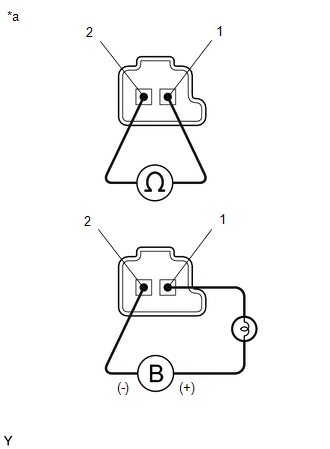 |
|
*a | Component without harness connected
(Solenoid (SL5) Valve) | | |
(b) Measure the resistance according to the value(s) in the table below.
Standard Resistance:
|
Tester Connection | Condition |
Specified Condition |
|
Solenoid (SL5) valve connector terminal 1 - terminal 2 |
20┬░C (68┬░F) | 5.0 to 5.6 ╬® |
(c)
Connect a positive (+) lead from the battery with a 21 W bulb to
terminal 1 and a negative (-) lead to terminal 2 of the solenoid valve
connector. Check that the valve moves and makes an operating sound.
OK:
Valve moves and makes an operating sound.
| OK |
 | REPAIR OR REPLACE TRANSMISSION WIRE |
| NG |
 | REPLACE SOLENOID (SL5) VALVE |
Parts Location
PARTS LOCATION
ILLUSTRATION
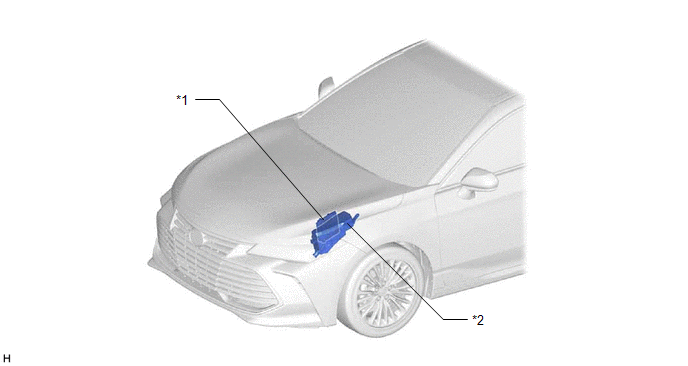
|
*1 | ECM |
*2 | NO. 1 ENGINE ROOM RELAY BLOCK AND NO. 1 JUNCTION BLOCK ASSEMBLY
- ST RELAY - EFI-MAIN NO. 1 FUSE - J/B-B FUSE - ETCS FUSE |
ILLUSTRATION
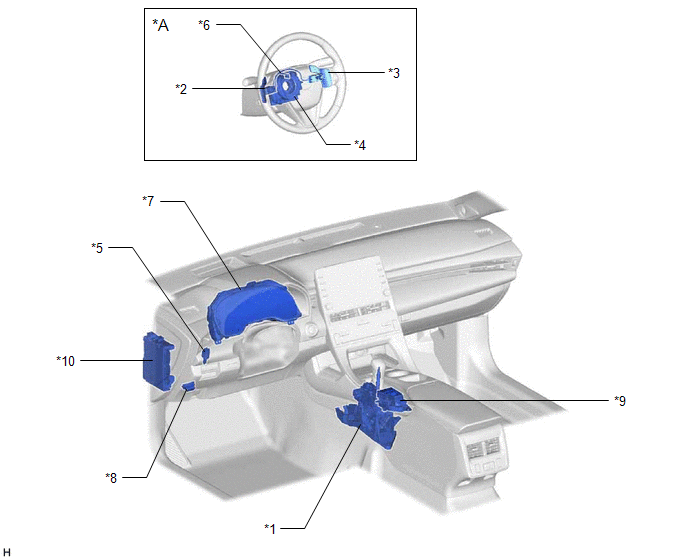
|
*A | w/ Shift Paddle Switch |
- | - |
|
*1 | SHIFT LOCK CONTROL UNIT ASSEMBLY
- TRANSMISSION CONTROL SWITCH |
*2 | SHIFT PADDLE SWITCH LH (NO. 1 TRANSMISSION SHIFT SWITCH ASSEMBLY) |
|
*3 | SHIFT PADDLE SWITCH RH (NO. 2 TRANSMISSION SHIFT SWITCH ASSEMBLY) |
*4 | SPIRAL CABLE SUB-ASSEMBLY |
|
*5 | STOP LIGHT SWITCH ASSEMBLY |
*6 | NO. 1 SWITCH WIRE |
|
*7 | COMBINATION METER ASSEMBLY |
*8 | DLC3 |
|
*9 | ELECTRIC PARKING BRAKE SWITCH ASSEMBLY (COMBINATION SWITCH)
- SPORT MODE SWITCH - NORMAL MODE SWITCH |
*10 | INSTRUMENT PANEL JUNCTION BLOCK ASSEMBLY
- STOP FUSE - ECU-ACC FUSE - BKUP LP FUSE - ECU-IG1 NO. 3 FUSE |
ILLUSTRATION
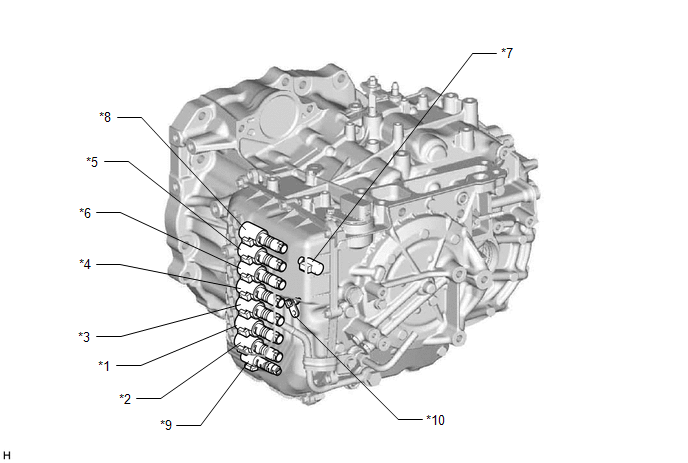
|
*1 | SOLENOID (SL1) VALVE |
*2 | SOLENOID (SL2) VALVE |
|
*3 | SOLENOID (SL3) VALVE |
*4 | SOLENOID (SL4) VALVE |
|
*5 | SOLENOID (SL5) VALVE |
*6 | SOLENOID (SL6) VALVE |
|
*7 | SOLENOID (SL) VALVE |
*8 | SOLENOID (SLU) VALVE |
|
*9 | SOLENOID (SLT) VALVE |
*10 | TRANSMISSION WIRE
- ATF TEMPERATURE SENSOR |
ILLUSTRATION

|
*1 | PARK/NEUTRAL POSITION SWITCH ASSEMBLY |
*2 | TRANSMISSION REVOLUTION SENSOR (NT) |
|
*3 | TRANSMISSION REVOLUTION SENSOR (NC) |
- | - |
Precaution
PRECAUTION
PRECAUTION FOR DISCONNECTING CABLE FROM NEGATIVE BATTERY TERMINAL
NOTICE:
When
disconnecting the cable from the negative (-) battery terminal,
initialize the following system(s) after the cable is reconnected:
|
System | See Procedure |
|
Lane Departure Alert System (w/ Steering Control) |
 |
|
Pre-collision System |
|
Intelligent Clearance Sonar System |
|
Lighting System (for Gasoline Model with Cornering Light) |
|
Parking Assist Monitor System |
|
Panoramic View Monitor System |
PROCEDURES NECESSARY WHEN ECU OR OTHER PARTS ARE REPLACED
NOTICE:
- If automatic transaxle parts are replaced, perform the following as
necessary referring to the table below: Parts Replacement Compensation
Table
| *1: When replacing with a new ECM
*2: When replacing with an ECM which was installed to another vehicle
|
|
Replaced Part |
Transaxle Compensation Code |
Reset Memory (Learned Values) |
Road Test |
|
Automatic transaxle assembly |
Input |
Reset |
Necessary |
|
Transmission valve body assembly |
Initialize |
Reset |
Necessary |
|
Solenoid (SL1, SL2, SL3, SL4, SL5 and/or SL6) valve |
Initialize |
Reset |
Necessary |
|
ECM
(If possible, read the transaxle compensation code from the previous ECM)
|
Possible to read transaxle compensation code |
Input (Into the new ECM) |
-*1
Reset*2 |
Necessary |
|
Impossible to read transaxle compensation code |
Initialize |
-*1
Reset*2 |
Necessary |
- Perform Registration (VIN registration) when replacing the ECM.
Click here 
- Before replacing the ECM or certification ECU (smart key ECU assembly), refer to Registration.
Click here 
- If either of the following conditions is met, perform ATF Thermal Degradation Estimate Reset:
Click here 
HANDLING PRECAUTIONS
CAUTION:
- Do not perform a stall test if there are any people or objects near the vehicle.
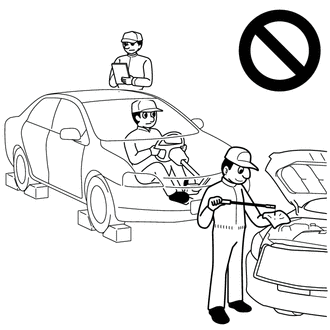
- The vehicle could begin moving suddenly, resulting in a serious accident.
- Do not perform a stall test if any wheel chocks are out of position.
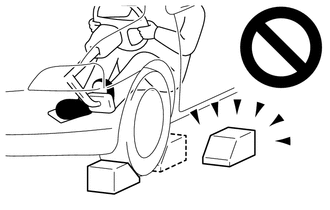
- The vehicle could begin moving suddenly, resulting in a serious accident.
- Do not perform the stall test on a slippery or low-friction surface that could allow the tires to spin.
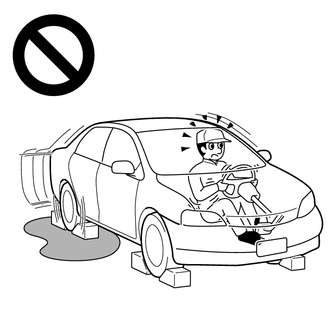
- The vehicle could begin moving suddenly, resulting in a serious accident.
- Do not blow compressed air without wearing safety glasses.
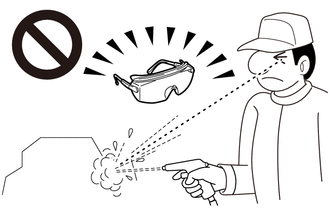
- Automatic Transaxle Fluid (ATF) could enter your eyes, possibly resulting in blindness.
NOTICE:
- The automatic transaxle assembly is composed of precision-made parts.
Careful inspection before reassembly is necessary because even a small
nick could cause fluid leakage or affect performance.
- The procedures are organized so that you work on only one component
group at a time. This will help avoid confusion with similar-looking
parts of different sub-assemblies being on your workbench at the same
time.
- The component groups are inspected and repaired from the converter housing side.
- Whenever possible, complete the inspection, repair and reassembly before
proceeding to the next component group. If a defect is found in a
certain component group during reassembly, inspect and repair this group
immediately. If a component group cannot be assembled because parts are
being ordered, be sure to keep all parts of the group in a separate
container while proceeding with disassembly, inspection, repair and
reassembly of other component groups.
- Use of Toyota Genuine ATF WS is recommended.
- All disassembled parts should be cleaned, and compressed air should be blown through any fluid passages and holes.
- Dry all parts with compressed air. Never use a piece of cloth.
- The recommended ATF or kerosene should be used for cleaning.
- After cleaning, the parts should be arranged in the order they were removed for efficient inspection, repair and reassembly.
- New brake discs and clutch discs must be soaked in ATF for at least 15 minutes before reassembly.
- All oil seal rings, clutch discs, clutch plates, rotating parts, and
sliding surfaces should be coated with ATF prior to reassembly.
- All old gaskets and rubber O-rings must be replaced.
- Do not apply adhesive cement to gaskets or similar parts.
- Make sure that the ends of snap rings are not aligned with any cutouts.
Make sure that snap rings are correctly installed into the grooves.
- If a worn bushing is to be replaced, the sub-assembly containing the bushing must also be replaced.
- Check the thrust bearings and races for wear or damage. Replace them if necessary.
- Use petroleum jelly to keep parts in place.
- When working with seal packing (FIPG), observe the following:
- Using a razor blade and a gasket scraper, remove all of the old seal packing (FIPG) from the gasket surface.
- Thoroughly clean all components to remove any seal packing (FIPG).
- Clean both sealing surfaces with a non-residue solvent.
- Parts must be reassembled within 10 minutes of application. Otherwise, the seal packing (FIPG) must be removed and reapplied.































